15 Fashionable Television Fandom in Season Two of The Bear (2023)
Ethan Geenen
From passive individuals to active networks, the way in which fans have been theoretically categorized is dependent on a continuum of participation and engagement, or lack thereof. In the case of television fandom, it is natural to revert to the preconceived image of the mass audience, a nebulous descriptor meant to address the so-called “average” viewer. However, these generalizations tend to be shallow in approach. For one, the displacement of television from its traditional set, as well as its subsequent diffusion across multiple devices and platforms, has resulted in an increasingly fragmented audience, marking such claims as antiquated. Secondly, these notions are largely predicated on the assumption that television is merely a source of face value entertainment, with very little intensive labour required of the viewer in return, if at all. Jenkins (1992) reasons that “television often competes with other household activities,” preventing the viewer from giving their full interest or undivided attention to what is on screen (p. 59). Although there are cases where this still holds true, such a narrow view of television audiences cannot be representative of the wide-ranging fan practices that emerge from this rich cultural form.
Undisputedly, the realm of criticism and theory has long been “reserved for an educated elite,” drawing an association between exceptionally high levels of engagement and the supposed legitimacy of academic status (Jenkins, 1992, p. 89). By contrast, television fandom is emblematic of how these discourses have been decentralized from their scholarly foundations. Indeed, it is more accurate to say that fans cultivate a “complex, fluid, and even contradictory” relationship to that which they consume, rather than anything so “monolithic” as the unquestioning mass audience (Gwenllian-Jones, 2002, p. 179). Certainly, isolation from fellow audience members generally makes analysis of theme and content far less likely, in addition to degrading the ritual dimension that once defined television (Costello & Moore, 2007, p. 135). Nonetheless, social media offers an accessible solution to the passivity of insular viewing. These online spaces function as an interpretive community, “where people discuss their delight and disgust at plotlines, dialogue, and character developments” (p. 135). This is a way of uniting and equalizing audience perspectives through a common text; after all, the only real prerequisite to membership is that shared interest itself. In fact, the basic exchange of opinions and reactions is powerful enough that it “enhances the enjoyment of the actual viewing experience,” thereby incentivizing engagement (p. 135). Beyond this, however, there exist more intricate frameworks of interpretation, evaluation, and identification through which television fans produce meaning.
On June 22, 2023, the second season of FX’s The Bear was released, welcoming casual viewers and avid bingers back into the chaotic world of a high-stakes Chicago restaurant operation. As the focus of this analysis, the show’s fandom is exemplary of participatory culture in a variety of settings. Perhaps most significant is the overwhelming presence of a distinct type of viewer, one thoroughly immersed in the details and situations of the program, such that it becomes a part of their daily lives. Even if most fan connections are transient in nature, this unique intersection of “fan identities and lived identities” indicates a more lasting sense of integration (Affuso & Scott, 2023, p. 1). Having strayed out of the hegemonic mainstream and into something more personalized, there is often a “mundane” quality to how fellow fans self-recognize themselves in relation to the text and each other (Beer & Burrows, 2010, p. 7). With The Bear, a single fandom can serve as an umbrella of expression under which several other interests converge, such as fashion, sexual appeal, and class commentary. Thus, the show demonstrates an everyday appeal to forensic, affective, and political fan exercises.
Character development is one major convention of television in which these discourses are often manifested. Beginning with forensic fandom, Mittell (2007) describes the concept of a “drillable text,” which encourages “seeking out clues, charting patterns and assembling evidence into narrative hypotheses and theories” as an arc is constructed. Elsewhere, he states that this collaborative investigation represents a desire “to understand the embedded representations of a fictional storyworld” (Mittell, 2015, p. 273). Hence, The Bear uses detail-oriented costume design to subtly convey character, rewarding attentive viewers with a chance at forming their own inferences and predictions going forward. This connection to clothing and material style, as well as the commercial practices it entails, are far from coincidental. With increasing visibility, Affuso (2018) believes that fandoms have evolved beyond the usual array of merchandising tie-ins to become more “fashion-forward” (p. 184). When understood in correlation to the “detective mentality” of forensic fans (Mittell, 2007), the significance is abundantly clear. The combination of television and fashion fandom invites a more rigorous form of participation, where viewers find themselves invested in the seemingly miniscule aspects of the show, as well as the central conceit which binds it.
In some instances, preoccupation with the decoding of visual or narrative signifiers can greatly impact more general interpretations of a program. Consider a fan theory shared to The Bear’s dedicated Reddit forum, an organized space, which posits that a happy ending for protagonist Carmy (Jeremy Allen White) could see him abandon the culinary world the show so vividly depicts, in order to pursue a career in art or fashion design (see Appendix A). This example is genuine, even if somewhat nearsighted to assume such a sudden diversion in the plot. Nonetheless, keen speculation into a television show’s perceived clues is evidentiary of forensic practices. In the comments under the post, fans express agreement or disagreement based on their own level of insight into the series; a meaning is proposed and afterward negotiated among a group. Furthermore, similar perspectives can appear on entirely different platforms, such as a fan-written Substack newsletter on menswear and style in general (Kernes, 2023). This presents an intriguing phenomenon; Kernes’ writing indicates that he is a fan of fashion first and The Bear second, rather than the other way around. In effect, there is no essential order to how these interests may coincide; instead, a multitude of individualized backgrounds and fan allegiances can happen to run relatively parallel to one another, arriving at the same conclusions. Both authors identify Carmy’s talent for sketching as a potential hint toward his character’s future endeavours, although Kernes goes so far as to entertain the possibility of an alternate reality. The key feature, however, does not come from the summary of their interpretations, but from sharing them in the first place.
By extension, fashion is a fan object in its own right; our personal style can reflect “our tastes as consumers and fans” (Affuso & Scott, 2023, p. 1). The process of searching for and recreating the outfits worn by characters in a show is another component of forensics. For example, pop culture outlets make reference to “the Internet sleuths” that discovered the origins of Carmy’s plain white t-shirts, tracking down the specific brands that sourced them (Renwick, 2023). Given how simple the object would appear to be, their forensic obsession over the exact line and label provides a stark contrast in how these fans operate. TikTok user Jake Woolf emphasizes the appeal in having access to “insider information” like this: “For guys in the know, the idea that [Carmy would] wear tees that are made the old-school way makes sense” (Corsillo, 2022). One Reddit user identifies the show’s costume designer Courtney Wheeler by name (see Appendix B), indicating a level of researched knowledge that only a forensic fan could accrue. Expectedly, this attention to detail can be capitalized on by commercial brands, who “circulate in the sharing economy of digital culture” (Affuso, 2018, p. 184). Numerous listicles provide a do-it-yourself wardrobe from the show, linking to high-end products from Ralph Lauren, Birkenstock, and COS, among others (Youl, 2023). This extreme sartorial inspiration is thus framed for the fan-as-consumer, rather than just as a viewer. Some sites that compile purchase options use marketing language to highlight the novelty of each piece. A patchwork jacket is referred to as “one of TV’s most elusive menswear grails,” making sure to mention its limited availability. The item was relaunched by the company NN07 due to the popular demand its appearance on The Bear created. In response, product director Anders Frost is quoted as saying, “We’re not about producing items that are hard to come by.” Other forms of promotion are more direct, such as fashion designer Thom Browne (2023) sharing images on his personal Instagram of a custom chef jacket made for Syd (Ayo Edebiri) in the season finale (see Appendix C).
For those not attuned to the inner workings of boutique fashion, fan-produced works offer a stylistic alternative. According to Jenkins (1992), these items “respond to the perceived tastes of their desired audience,” existing outside of the dominant commercial culture (p. 91). Essentially, the fan-as-entrepreneur blurs the lines of production and consumption, thereby widening the merchandise base (Beer & Burrows, 2010, p. 6). For example, a Reddit user posted a picture of a replica “The Original Berf” shirt, complete with the same printing error from the show (see Appendix D). Notably, this is not available from any official source associated with The Bear; a comment in the same thread namedrops Obvious Tees, a Chicago-based fan group whose “quality exceeded my expectations” (see Appendix E). Renwick (2023) identifies this as part of a broader trend in restaurant-related t-shirts, proliferated by sellers on marketplaces like Etsy. Their custom-made exclusivity bears “gift economy” value, while also establishing “an affective link between consumer and entrepreneur” (Affuso & Scott, 2023, p. 8). There is no question that brands and fans alike engage in similar practices, but what is it that makes fandom fashionable in the first place, beyond cultivating a personal style? The answer is recognition.
Just as some find delight in catching The Bear’s niche fashion references, so too is there a drive to replicate those in the real world. As a concept, cosplay is traditionally associated with fan conventions and elaborate costuming, but it has since expanded to cover everyday notions of “performative consumption” (Affuso, 2018, p. 188). Another Reddit post includes an image of the names Claire and Carmy etched into a sidewalk, a clear signifier of the show in a public place (see Appendix F). However, the comment section reveals another layer of identification. One user notices the Birkenstock Boston boots of the photo taker, remarking “there’s a reason all the chefs wear ‘em” (see Appendix G). It would seem that the bond between fashion and the culinary arts is bigger than just The Bear, merely replicated as part of its authentic portrayal. Fan knowledge thus overlaps such that career chefs, clothing afficionados, and inquisitive viewers of the show alike can appreciate the details it offers.
On the other hand, dressing up for Halloween is a much more explicit example of traditional cosplay, signifying a desire to be recognized by fellow fans. A Reddit thread on the topic calls a Carmy outfit a “one for me” costume, and fellow users compare the “rate of recognition” based on their geographic locations (see Appendix H). Unsurprisingly, the group determined it was highest in the River North neighbourhood of Chicago, where the show actually takes place, and much lower in the Bay Area of Los Angeles. For many, this is a metric of success, with some commenters sharing an exchange of the catchphrase “Yes, chef!” among fellow fans (see Appendix I). For those who were not recognized, Affuso (2018) asserts that there is still some fannish appeal to wearers who do it for their own enjoyment, rather than for others (p. 188). “Oh well, wasn’t for them anyways!” insists another commenter (see Appendix J). Regardless of their intentions, these fans from completely different parts of the United States are able to find the acknowledgement they crave within this virtual space.
When it comes to fashion, the psychology of sexual appeal is often the single biggest determinant in aesthetic value, however problematic this may be. Consider the introspective nature of this comment from the same Halloween thread regarding the ideal Carmy costume:
“Carmy is the ‘I don’t wanna try too hard, but I do want to look hot’ costume for men in the 25-35 demographic…at least in Los Angeles (where I am), though I assume in New York and Chicago as well. I don’t think you’ll have a problem being recognized, but the details matter. I think it tends to look better on men who already have longer/curly hair, and taking the time to draw on Carm’s more recognizable tattoos will go a long way. And opt for a crisp white t-shirt that really elevates that Buff Chef look.” (see Appendix K)
With this statement, it is clear that “notions of beauty,” or hotness, have become “tools of fan engagement” with intrinsic ties to fashion and style (Affuso, 2018, p. 186). As such, there are many different ways to read into the sexuality of The Bear fans. Pop culture writers tend to boil down the trending takes on the show fairly bluntly. “There has been a lot of drooling recently over Jeremy Allen White’s character,” Corsillo (2022) writes, citing “all the memes about our collective desire to answer him with a willing ‘Yes, chef’ and some people’s fantasies of becoming the floor he so obsessively scrubs.” Wehniainen (2023) awards Carmy the “Emmy for Hunkiest TV Chef” and recycles the same bit: “For many viewers, it was the muscly, tattooed arms and cool demeanor that really had them saying, ‘Yes, chef.’” This also represents the semiotic flexibility of the show’s catchphrase, here reappropriated by fans in a thinly veiled sexual context. Even the original Tweet by Kayla Ancrum (2022), which uncovered the lineage of Carmy’s t-shirts, makes note of the “shorter sleeves (for muscle viewing obviously)” (see Appendix L). Although often exaggerated to optimize interaction and heighten comedic affect, each of these embody the tone of an online “thirst” culture which is predominantly straight. Yet there are some viewers who prefer a queer position on the text. Twitter user Joe Reid (2023) asks, “I think season 3 should involve [the character played by] Will Poulter coming to Chicago and kissing as many of the main characters as possible, who’s with me?” (see Appendix M). This expression of fan desire is one of many multifaceted fan practices, perhaps reflecting the lived identities of those who choose to participate in them.
The discourse of taste, as Jenkins (1992) says, is “rooted in social experience and reflects particular class interests” (p. 16). Ergo, sexuality and fashion also intersect with economic position. The aestheticization of the working class is something many fans have responded to positively. In a New York Times analysis, Chocano (2022) makes a case for The Bear as an accurate portrayal of the modern working world in all its chaos. This becomes a criticism of the American “hustle” culture, where everyone is “in survival mode all the time.” An independent WordPress blog dives deeper into the labour rights of the service economy that the show explores, with an affective plea to “understand why work matters, and what workers might be longing for” in their jobs (Linkon & Russo, 2022). These ideological explorations of the text are more in line with activism than the practices that have come before, which favoured a more insulated kind of awareness. Appropriately, Dean (2017) holds that the politicization of fandom results in an “outwardly oriented […] desire to change wider society,” contrary to the more straightforward relationship “between fan, fan object and fellow fans” (p. 413). The respective authors of these articles search for political narratives “that correspond with their expectations and that support their affective reading of the fan object” (Sandvoss, 2013, p. 278). Whether or not this makes a difference? Celebrity chef Rick Bayless believes the show’s negative representation of the industry has caused “permanent damage” (Selvam, 2023). Regardless, as a privileged elite, Bayless represents the type of perspective that the fan-as-critic subverts, and his concerns seem to reinforce fan audiences as being active and engaged with the text. It is no surprise the show attracts the consensus of the exploited to contradict the voice of upper-class figureheads. Even Carmy’s menswear is allegedly “an antidote to the Succession-style stealth-wealth monotone malaise,” as costume designer Wheeler states, sustaining a dialogue with the awards-competitive HBO drama nominated alongside The Bear at the Emmys (Woolf, 2023). She continues: “I feel like this ‘quiet luxury’ stuff is stopping people from making a choice that can punch up a wardrobe.” In a more immediate sense, however, these writings do not represent all perspectives, or necessarily speak to the views of the working class in the first place. Indeed, there remains an economic difference in the style of the show’s characters, which some fans have noticed. For example, a Reddit user inquiring about the cost of the custom Thom Browne coat is right to question how the down-on-their-luck chefs were able to afford it (see Appendix N). One commenter summarizes the tone-deaf fallacy of The Bear’s claim to the working class: “I’ve never felt more poor than looking at a plain white button down that costs 475 bucks” (see Appendix O). With this, it is clear that fashionable fandom cannot be divorced from a class context.
In concluding this analysis, it is necessary to restate how fan communities ultimately act as equalizing sites for subversive discussion and expression. As has been observed, the affective responses of fans cultivate a level of television engagement that “puts academic critics to shame” (Jenkins, 1992, p. 89). Through this comprehensive overview of The Bear’s fashion fandom, it is apparent that meaning is constructed through the intersection of forensics, cosplay, and identity, whether it be collective or individual. Therefore, as these shared values weave into the literal fabric of the everyday, fans of the show are connected through what they wear and what they share.
Appendix A
A fan theory post made to the dedicated The Bear forum on Reddit (batmanforhire, 2023).
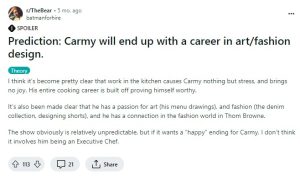
Appendix B
A fashion-related discussion post made to the dedicated The Bear forum on Reddit (SearchMontage, 2023).

Appendix C
An Instagram post promoting a fashion item featured on The Bear (Browne, 2023).
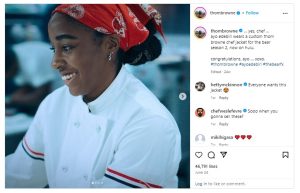
Appendix D
An image of a fan-made t-shirt posted to the dedicated The Bear forum on Reddit (Special_Analysis_526, 2023).
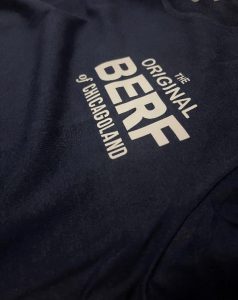
Appendix E
A user comment posted in reply to the thread in Appendix D.

Appendix F
An image of a public The Bear reference posted to the show’s dedicated forum on Reddit (funkmasterem, 2023).
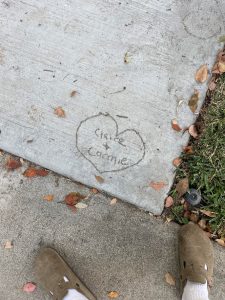
Appendix G
A user comment posted in reply to the thread in Appendix F.

Appendix H
A discussion post on Halloween costume recognition made to the dedicated The Bear forum on Reddit (ultrapoppy, 2023).
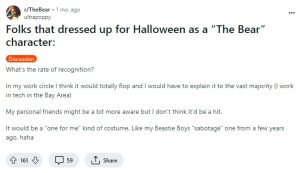
Appendix I
A user comment posted in reply to the thread in Appendix H.

Appendix J
A second user comment posted in reply to the thread in Appendix H.

Appendix K
A third user comment posted in reply to the thread in Appendix H.

Appendix L
A Tweet discussing the t-shirts worn by Carmy on The Bear (Ancrum, 2023).
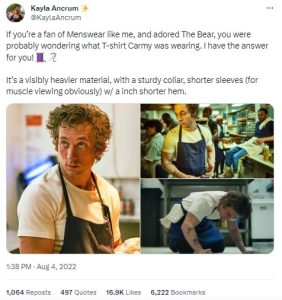
Appendix M
A Tweet discussing characters on The Bear kissing (Reid, 2023).

Appendix N
A discussion post on a Thom Browne item made to the dedicated The Bear forum on Reddit (ultrapoppy, 2023).

Appendix O
A user comment posted in reply to the thread in Appendix N.

Works Cited
Affuso, E. (2018). Everyday Costume: Feminized Fandom, Retail, and Beauty Culture. In M. Click & S. Scott (Eds.), The Routledge Companion to Media Fandom (pp. 184–192). Routledge.
Affuso, E., & Scott, S. (2023). Introduction: Fandom, But Make It Fashion. In E. Affuso & S. Scott (Eds.), Sartorial Fandom: Fashion, Beauty Culture, and Identity (pp. 1–16). University of Michigan Press. http://www.jstor.org/stable/10.3998/mpub.12315327.5
Ancrum, K. [@KaylaAncrum]. (2022, August 4). If you’re a fan of Menswear like me, and adored The Bear, you were probably wondering what T-shirt Carmy was wearing. [Images attached] [Tweet]. Twitter. https://twitter.com/KaylaAncrum/status/1555246791209222144
[batmanforhire]. (2023, July 6). Prediction: Carmy will end up with a career in art/fashion design. [Online forum post]. Reddit. https://www.reddit.com/r/TheBear/comments/14sink8/prediction_carmy_will_end_up_with_a_career_in/
Beer, D., & Burrows, R. (2010). Consumption, Prosumption and Participatory Web Cultures: An introduction. Journal of Consumer Culture, 10(1), 3–12. https://doi.org/10.1177/1469540509354009
Browne, T. [@thombrowne] (2023, June 24). … yes, chef … ayo edebiri wears a custom thom browne chef jacket for the bear season 2, now on hulu. [Images attached]. Instagram. https://www.instagram.com/p/Ct42Yf0LZff/
Chocano, C. (2022, August 3). How “The Bear” Captures the Panic of Modern Work. The New York Times. https://www.nytimes.com/2022/08/03/magazine/the-bear-modern-work.html
Corsillo, L. (2022, July 22). With Help from Menswear Reddit, We Found Jeremy Allen White’s Tees From The Bear. The Strategist. https://nymag.com/strategist/article/white-t-shirts-from-tv-show-the-bear.html
Costello, V., & Moore, B. (2007). Cultural Outlaws: An Examination of Audience Activity and Online Television Fandom. Television & New Media, 8(2), 124–143. https://doi.org/10.1177/1527476406299112
Dean, J. (2017). Politicising fandom. The British Journal of Politics and International Relations, 19(2), 408–424. https://doi.org/10.1177/1369148117701754
[funkmasterem]. (2023, December 4). Is this a coincidence? Spotted on my walk [Image attached] [Online forum post]. Reddit. https://www.reddit.com/r/TheBear/comments/18b16rz/is_this_a_coincidence_spotted_on_my_walk/
Gwenllian-Jones, S. (2002). Phantom menace: Killer fans, consumer activism and digital filmmakers. In X. Mendik & L. Kaufman (Eds.), Underground USA: Filmmaking Beyond the Hollywood Canon (pp. 169–179). Wallflower Press.
[heloouwu]. (2023, July 10). How much did that piece of clothing cost? [Online forum post]. Reddit. https://www.reddit.com/r/TheBear/comments/14vucqt/how_much_did_that_piece_of_clothing_cost/
Jenkins, H. (1992). Textual Poachers: Television Fans and Participatory Culture. Routledge.
Kernes, V. (2023, July 1). Presentable #26: Binging “The Bear” (Season 2). Presentable. https://presentable.substack.com/p/presentable-26-binging-the-bear-season
Linkon, S., & Russo, J. (2022, August 29). The Bear and the Contradictions of Work. Working-Class Perspectives. https://workingclassstudies.wordpress.com/2022/08/29/the-bear-and-the-contradictions-of-work/
Mittell, J. (2007, October 23). Lost in a Great Story. Just TV. https://justtv.wordpress.com/2007/10/23/lost-in-a-great-story/
Mittell, J. (2015). Complex TV: The Poetics of Contemporary Television Storytelling. New York University Press.
Reid, J. [@joereid]. (2023, June 22). Speaking of why not, I think season 3 should involve Will Poulter coming to Chicago and kissing and many of the main characters as possible, who’s with me? [Tweet]. Twitter. https://twitter.com/joereid/status/1671920666327613441
Renwick, F. (2023, July 27). The Bear guide to really (really) good T-shirts. British GQ. https://www.gq-magazine.co.uk/article/the-bear-season-2-tshirts
Sandvoss, C. (2013). Toward an understanding of political enthusiasm as media fandom: Blogging, fan productivity and affect in American politics. Participations: Journal of Audience & Reception Studies, 10(1), 252–296.
[SearchMontage]. (2023, August 22). Male character expression through clothing [Online forum post]. Reddit. https://www.reddit.com/r/TheBear/comments/15yeywi/male_character_expression_through_clothing/
Selvam, A. (2023, June 23). Rick Bayless Rips “The Bear” for Glorifying the Ugliness of Restaurants. Eater Chicago. https://chicago.eater.com/2023/6/23/23771531/the-bear-rick-bayless-hot-take-fx-tv-show-opinion-hulu
[Special_Analysis_526]. (2023, December 6). collector’s item [Image attached] [Online forum post]. Reddit. https://www.reddit.com/r/TheBear/comments/18ct0ve/collectors_item/
[ultrapoppy]. (2023, October 31). Folks that dressed up for Halloween as a “The Bear” character [Online forum post]. Reddit. https://www.reddit.com/r/TheBear/comments/17ktezx/folks_that_dressed_up_for_halloween_as_a_the_bear/
Wehniainen, G. (2023a, June 22). Twitter Loves Will Poulter As Luca On The Bear. Bustle. https://www.bustle.com/entertainment/will-poulter-luca-the-bear-tweets-memes-reactions
Woolf, J. (2023, October 4). You Can Finally Buy Carmy’s Patchwork Jacket from “The Bear.” GQ. https://www.gq.com/story/the-bear-nn07-jacket-relaunch
Youl, P. (2023, July 14). The Bear: How To Recreate The Show’s Effortless Chef Style. Urban List. https://www.theurbanlist.com/a-list/shop-the-bear-fashion

